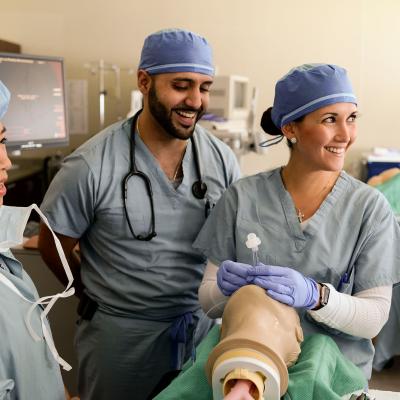- AdventHealth University

Healthcare is one of the fastest growing industries, thanks in large part to an increased demand for health services. By 2026, the industry is expected to add around 2.4 million jobs1 at a growth rate of 18%. Not only does healthcare offer plenty of career opportunities, it also tends to pay more than other occupations. The median annual salary for many healthcare professions is considerably higher than other industries. Coupling that with the large growth, transitioning into the healthcare arena could be a successful career change or opportunity for growth.
Take a look at some of the fastest growing careers in healthcare. The five careers below not only offer higher-than-average median salaries, they are also expected to have high rates of growth, and plenty of job opportunities over the next 10 years.
Diagnostic Medical Sonographer
Diagnostic Medical Sonographers operate ultrasound equipment to capture images that help doctors diagnose diseases or determine what is going on in a patient’s body. Diagnostic Medical Sonographers can specialize in areas of the body, such as the abdomen, vascular system, or cardiovascular system. Some specialize in obstetrics to capture fetal images for monitoring growth and development.
Many Diagnostic Medical Sonographer positions require the technologist to have at least a post-secondary certificate or an associate degree from an accredited program. Sonographers who are interested in moving into leadership roles or advancing their careers should consider pursuing a bachelor’s degree.
- Number of Jobs (2016)2: 67,300
- Projected Number of New Jobs (2016-2026): 15,600 (+23%)
- Median Salary (2018): $72,510
MRI Technologist
MRI technologists produce images for diagnostic purposes by operating magnetic resonance imaging (MRI) scanners. They provide direct patient care, ensure the safety of the patients, and use effective communication to help patients feel comfortable during the exam. MRI technologists manipulate setting on the MRI scanner to create anatomic images from any angle and even produce 3D images.
If you already have primary certification from the American Registry of Radiologic Technologists (ARRT) or Nuclear Medicine Technology Certification Board (NMTCB), you can pursue a career as an MRI technologist by enrolling in an advanced imaging certificate program. Earning an advanced certificate will prepare you for the ARRT’s MRI certification exam, which will help you begin a new career as an MRI technologist.
- Number of Jobs (2016)3: 36,600
- Number of New Jobs (2016-2026): 5000 (+14%)
- Median Salary (2018): $71,670
Nuclear Medicine Technologist
Nuclear Medicine Technologists work directly with patients and alongside physicians to help diagnose and treat illnesses. A nuclear medicine technologist will often inject patients with radiopharmaceuticals, or radioactive drugs, which help a doctor determine what is going on inside of a patient’s body. Radiopharmaceuticals can also be used to treat issues in the body, such as tumors.
You can become Nuclear Medicine Technologist by earning an associate’s or bachelor’s degree in the field. As a Nuclear Medicine Technologist, you will often work with Computed Tomography in the form of PET and SPECT imaging. Obtaining an advanced imaging certificate in Computed Tomography can help you stand out in your nuclear medicine career, giving you a competitive edge for employment.
- Number of Jobs (2016)4: 20,100
- Number of New Jobs (2016-2026): 2,000 (+10%)
- Median Salary (2018): $76,820
Registered Nurse
Registered Nurses (RNs) provide direct care to a wide variety of patients. They might work with people who are generally healthy and seeking preventative care or with patients who are ill or injured. Registered Nurses are usually supervised by doctors and might provide supervision to Medical Assistants or Nursing Assistants.
There are several ways to become an RN. Some earn a diploma or an associate degree in nursing then pass the National Council Licensure Examination (NCLEX-RN) to earn their license. Bachelor’s degree programs in nursing (BSN) are becoming the new standard and are often the program of choice for new nurses. Often, RNs who already have a diploma or associate degree will enroll in an RN-to-BSN program to help advance their career, preparing them for leadership positions. If a hospital is pursuing Magnet Recognition® from the American Nurses Credentialing Center (ANCC), they are more likely to hire BSN-prepared nurses.
- Number of Jobs (2016)5: 2,955,200
- Number of New Jobs (2016-2026): 438,100 (+15%)
- Median Salary (2018): $71,730
Nurse Practitioner
A Nurse Practitioner also works with patients as part of a healthcare team, taking on a lead role in patient care. They are often the primary care provider in many settings, making diagnoses, and prescribing any necessary medications and treatment plans. Nurse practitioners begin their careers as RNs, then pursue graduate-level education, such as a Master of Science in Nursing.
Nurse Practitioner is one of the fastest growing jobs in the healthcare field, with projections estimating a 36% increase in the number of available positions by 2026.
- Number of Jobs (2016)6: 155,500
- Number of New Jobs (2016-2026): 56,100 (+36%)
- Median Salary (2018): $107,030
AHU Online offers a wide range of programs for working professionals within the healthcare industry ready to take the next step in their career. Our programs range from advanced certificates in fast-growing careers to prestigious master’s degrees. To learn more, speak to one of our admissions counselors today.
Notes:
- Healthcare Occupations, Bureau of Labor Statistics, April 12, 2019, https://www.bls.gov/ooh/healthcare/home.htm
- Diagnostic Medical Sonographers, Bureau of Labor Statistics, April 12, 2019, https://www.bls.gov/ooh/healthcare/diagnostic-medical-sonographers.htm
- Radiologic and MRI Technologist, Bureau of Labor Statistics, April 12 2019, https://www.bls.gov/ooh/healthcare/radiologic-technologists.htm
- Nuclear Medicine Technologists, Bureau of Labor Statistics, April 12, 2019, https://www.bls.gov/ooh/healthcare/nuclear-medicine-technologists.htm
- Registered Nurses, Bureau of Labor Statistics, April 12, 2019, https://www.bls.gov/ooh/healthcare/registered-nurses.htm
- Nurse Anesthetists, Nurse Midwives, and Nurse Practitioners, Bureau of Labor Statistics, April 12, 2019, https://www.bls.gov/ooh/healthcare/nurse-anesthetists-nurse-midwives-and-nurse-practitioners.htm


